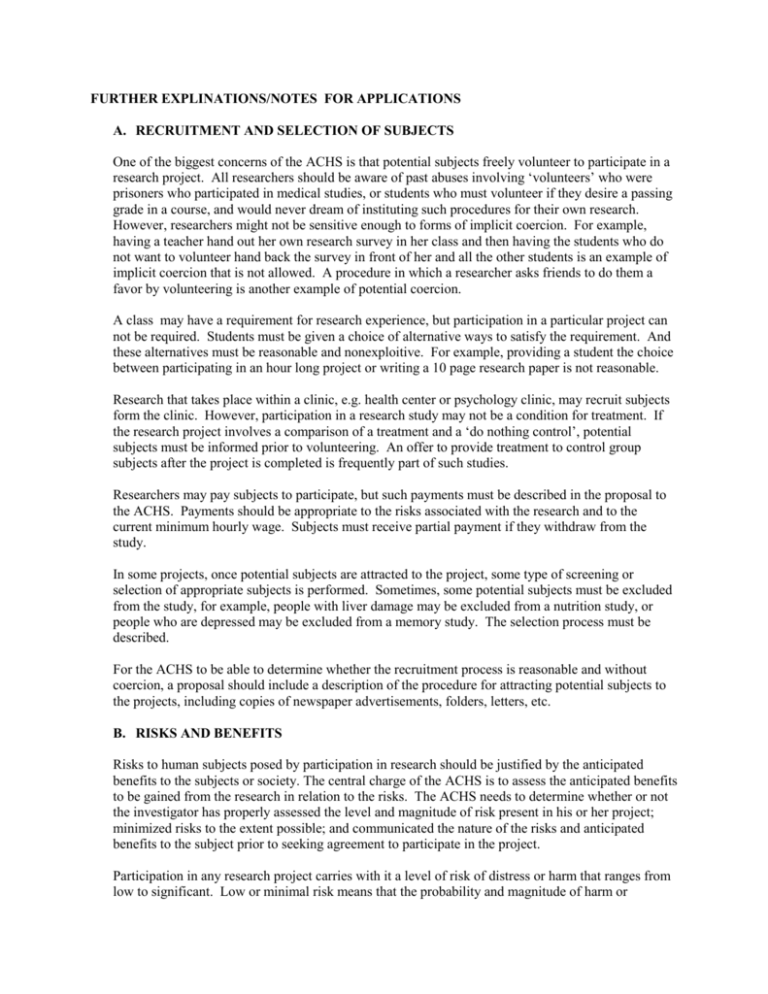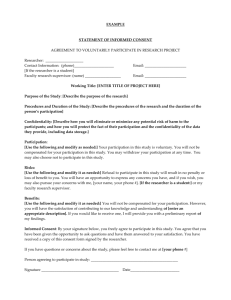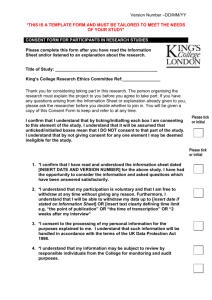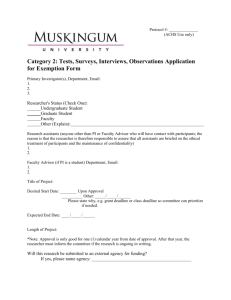a. recruitment and selection of subjects
advertisement

FURTHER EXPLINATIONS/NOTES FOR APPLICATIONS A. RECRUITMENT AND SELECTION OF SUBJECTS One of the biggest concerns of the ACHS is that potential subjects freely volunteer to participate in a research project. All researchers should be aware of past abuses involving ‘volunteers’ who were prisoners who participated in medical studies, or students who must volunteer if they desire a passing grade in a course, and would never dream of instituting such procedures for their own research. However, researchers might not be sensitive enough to forms of implicit coercion. For example, having a teacher hand out her own research survey in her class and then having the students who do not want to volunteer hand back the survey in front of her and all the other students is an example of implicit coercion that is not allowed. A procedure in which a researcher asks friends to do them a favor by volunteering is another example of potential coercion. A class may have a requirement for research experience, but participation in a particular project can not be required. Students must be given a choice of alternative ways to satisfy the requirement. And these alternatives must be reasonable and nonexploitive. For example, providing a student the choice between participating in an hour long project or writing a 10 page research paper is not reasonable. Research that takes place within a clinic, e.g. health center or psychology clinic, may recruit subjects form the clinic. However, participation in a research study may not be a condition for treatment. If the research project involves a comparison of a treatment and a ‘do nothing control’, potential subjects must be informed prior to volunteering. An offer to provide treatment to control group subjects after the project is completed is frequently part of such studies. Researchers may pay subjects to participate, but such payments must be described in the proposal to the ACHS. Payments should be appropriate to the risks associated with the research and to the current minimum hourly wage. Subjects must receive partial payment if they withdraw from the study. In some projects, once potential subjects are attracted to the project, some type of screening or selection of appropriate subjects is performed. Sometimes, some potential subjects must be excluded from the study, for example, people with liver damage may be excluded from a nutrition study, or people who are depressed may be excluded from a memory study. The selection process must be described. For the ACHS to be able to determine whether the recruitment process is reasonable and without coercion, a proposal should include a description of the procedure for attracting potential subjects to the projects, including copies of newspaper advertisements, folders, letters, etc. B. RISKS AND BENEFITS Risks to human subjects posed by participation in research should be justified by the anticipated benefits to the subjects or society. The central charge of the ACHS is to assess the anticipated benefits to be gained from the research in relation to the risks. The ACHS needs to determine whether or not the investigator has properly assessed the level and magnitude of risk present in his or her project; minimized risks to the extent possible; and communicated the nature of the risks and anticipated benefits to the subject prior to seeking agreement to participate in the project. Participation in any research project carries with it a level of risk of distress or harm that ranges from low to significant. Low or minimal risk means that the probability and magnitude of harm or discomfort is no more than engaging in everyday activities or during the performance of routine physical or psychological examinations or tests (e.g., drawing a small amount of blood from a healthy person, or sitting through an hour of tests). Some studies may involve a middle level of risk in which there is expectation of some temporary distress on the part of the subject (e.g. being asked to justify immoral decisions). High or significant risk means that the subjects may experience serious or lasting harm, (e.g. suffer a heart attack while participating in an exercise training program or be exposed to legal, financial or personal repercussions if their responses become known outside the research). A high level of risk is not a sufficient reason to disapprove a proposal; if the anticipated benefits of performing the research are high, and subjects are fully informed of the risks, then a proposal with a high level of risk may be approved. Benefits of research fall into two major categories: benefits to the subjects and benefits to society. Subjects who are undergoing clinical treatment or examination may benefit directly from research involving evaluation of a procedure, better treatment or understanding of their disorder. Frequently, however, research projects have no immediate therapeutic intent for the subject. However, there may be benefits to society as a whole from the increased knowledge, improved safety, better technology, or improved practice in a field. Direct payments to subjects as an incentive or reward for participation should not be considered a “benefit” to be gained from research. C. INFORMED CONSENT Informed consent refers to a person's freely made decision to participate in a research project based on full knowledge of relevant aspects of the project and its implications for the participant's welfare. It is an ongoing process in which participants are given an explanation of the research project in language that they can understand. In most cases, subjects are informed about proposed research and the risks associated with the project via a written consent form; in fact Federal regulations require written consent. The consent form describes the project and its risks; it also provides sources of additional information if the subject has questions about the project or his or her rights. The investigator shall give the subject or the representative adequate opportunity to read the consent form, or it may be read to them, and to have any questions about the study answered before it is signed. The signature of the subject on this form documents the fact that the subject has been fully informed about the project. A copy of the form needs to be given to the person signing the form. It is important that investigators include a copy of this form with their ACHS application so that the ACHS can determine whether or not the subjects have been fully informed. 1. BASIC ELEMENTS OF INFORMED. The written consent document shall include information on the following basic elements of informed consent written in language readily understandable by the subjects. a. Description of the Research: The nature, purpose and significance of the research. b. Research Procedures: The procedures to be followed. Plans to audiotape or videotape any sessions or photograph participants need to be described and explicitly agreed to by participants on the consent form. c. Time Required for Participation: The expected frequency and duration of each procedure and total amount of time required for participation. d. Risks: Any reasonably foreseeable risks or discomforts to the subjects. e. Benefits: Any benefits to the subject or others which may reasonably be expected from the research. f. Alternative Treatments: Disclosure of appropriate alternative procedures or courses of treatment, if any, that might be advantageous to the subject. This section is applicable primarily to medical studies. g. Confidentiality: The extent to which confidentiality of records identifying the subject will be maintained. Note: Data should not be described as anonymous if there are any identifying names or numbers through which individual subjects could be linked by the researcher or anyone else to his or her responses. h. Voluntary Participation: A statement that: • participation is voluntary, • refusal to participate will involve no penalty or loss of benefits to which the subject is otherwise entitled, • the subject may discontinue participation at any time or refuse to answer specific questions without penalty or loss of benefits to which the subject is otherwise entitled. i. Questions About the Study: An offer to answer any questions about the procedures and an explanation of whom to contact (the name, phone number and email address of the investigator and, in the case of student investigators, the faculty advisor) for answers to pertinent questions about the research. Where applicable, provide the name of a contact in the event of a research-related injury to the subject. j. Questions About Rights of Subjects: A statement that subjects may contact the Animal Care and Human Subjects Committee at achs@muskingum.edu or (phone number) for questions about their rights as subjects. k. Compensation for Injury: For research involving more than minimal risk, an explanation as to whether any compensation or medical treatment is available if injury occurs, and, if so, what they consist of, or where additional information may be obtained. A short-form written consent document may be used, stating that the elements of informed consent have been presented orally to the subject or the subject’s legally authorized representative. When this method is used, there shall be a witness to the oral presentation. The ACHS shall approve a written summary of what is to be said to the subject or representative. A copy of the written statement about the research study and the short-form consent document shall be given to the subject or representative. 2. CONSENT/ASSENT FROM SPECIAL POPULATIONS a. Subjects Under Age 18. When the subjects are younger than 18 years of age, including college students, a parent or legal guardian must sign a written consent form. In addition, the child should be asked to ‘assent’ to participate. For older children, e.g. older than 14, this assent should be written. For younger children, this assent should be verbal. Researchers need to provide a script of what will be said to children to seek their agreement to participate. b. Vulnerable Adults. When participants include individuals who are not legally or physically capable of giving documented informed consent because of mental incapacity, or inability to communicate, consent must be sought from a legal guardian as well as assent from the subjects themselves. The subjects should also be given an explanation of the procedures at a level appropriate to their condition and asked for their assent to participate in the research project. A written form to document assent may also be appropriate for mildly impaired adults. 3. WAIVER OF SOME ELEMENTS OF THE CONSENT PROCESS Although the use of a written informed consent form is highly encouraged by the ACHS, it is understood that there are situations in which the use of such a form creates problems and therefore the investigator may request a waiver to the requirement to document informed consent in writing. In these cases, the researcher should state in Section 6 of the application “I request a waiver to the requirement to document informed consent in writing” and provide the information the ACHS needs to justify waiving the requirement. Examples of situations that the ACHS will normally waive the written consent form requirement include: a. Protecting the identity of participants. The requirement for a signed consent form may be waived when the only record linking the subject and the research would be the consent document and the principal risk would be potential harm resulting from a breach of confidentiality. b. Cross cultural research. If the project involves people in a culture where signed consent forms are not appropriate, the researcher should propose alternative ways to assure that participants fully understand and willingly participate in the research. Usually, verbal consent is required by the ACHS. A script describing the procedure should be included in the application. D. EXEMPT STATUS REQUEST. Research activities in which the only involvement of human subjects will be in one or more of the following categories may be exempt from some of the requirements of the federal guidelines including signed consent. List the appropriate category that applies to your research project in section 7 of your Research Description. 1. Research conducted in established or commonly accepted educational settings involving normal educational practices, such as: a. research on regular and special education instructional strategies; or b. research on the effectiveness of or the comparison among instructional techniques, curricula, or classroom management methods. NOTE: This category may be applied to research involving children. 2. Research involving the use of educational tests (cognitive, diagnostic, aptitude, achievement), survey procedures, interview procedures, or observation of public behavior, unless: a. information obtained is recorded in such a manner that human subjects can be identified, directly or through identifiers linked to the subjects; and b. any disclosure of the identifiable human subjects' responses outside the research could reasonably place the subjects at risk of criminal or civil liability or be damaging to the subjects' financial standing, employability, or reputation. NOTE: Surveys on sensitive or personal topics which may cause stress to study participants are not eligible for exempt status. The section of this category pertaining to standardized educational tests may be applied to research involving children. This category may also apply to research with children when the investigator observes public behavior but does not participate in that behavior or activity. No exemptions are allowed for survey, interview, or participant observation research involving children, including college students under age 18. 3. Research involving the use of educational tests (cognitive, diagnostic, aptitude, achievement), survey procedures, interview procedures, or observation of public behavior that is not exempt under category 2, if: a. the human subjects are elected or appointed public officials or candidates for public office; or b. Federal statute(s) require(s) without exception that the confidentiality of the personally identifiable information will be maintained throughout the research and thereafter. 4. Research involving the collection or study of existing data, documents, records, pathological specimens, or diagnostic specimens if: a. these sources are publicly available, or b. if the information is recorded by the investigator in such a manner that subjects cannot be identified either directly or through identifiers linked to the subjects. 5. Research and demonstration projects conducted by or subject to the approval of Federal Department or Agency heads, if the projects are designed to study, evaluate, or otherwise examine: a. public benefit or service programs; b. procedures for obtaining benefits or services under those programs; c. possible changes in or alternatives to those programs or procedures; or d. possible changes in methods or levels of payment for benefits or services under those programs. 6. Taste and food quality evaluation and consumer acceptance studies a. if wholesome foods without additives are consumed, or b. a food is consumed that contains a food ingredient at or below the level and for a use found to be safe, or agricultural chemical or environmental contaminant at or below the level found to be safe by the Food and Drug Administration or approved by the Environmental Protection Agency or the Food Safety and Inspection Service of the U. S. Department of Agriculture. E. CONFIDENTIALITY OF INFORMATION There is a difference between confidentiality and anonymity. Confidentiality refers to the situation in which a dataset and/or research materials include personal identifiers, such as a name, photograph, sound recording, or personal references such as an address, phone number or identification number that may be used to identify a particular subject and his or her data. Although the researcher has ready access to the information, it is the responsibility of the researcher to develop procedures that insure that no one else has access. At minimum, the information should be kept in an inaccessible place, e.g. a locked file cabinet. If the data is maintained in a computer system, then the system should be protected from outsiders. Researchers should be aware that there are legal means by which confidential information can be made public. Anonymity refers to the situation in which the dataset and/or research materials contain no personal identifiers through which anyone, including the investigator, could connect individual responses with a specific subject. Data collected through face-to-face interviews, and video, audio or photographic records are not anonymous. Usually as long as personal identifiers are present in a dataset, the researcher is responsible for maintaining the confidentiality of the dataset, and therefore, the research project will receive periodic review (at least annually) to insure that the procedures used to guarantee confidentiality are adequate. However, the ACHS recognizes that in some research projects, the identity of the subjects is integral to the study and therefore the research material will contain the identity of the person; oral histories and qualitative clinical studies are examples of this type of research. In these cases, the researcher may petition the ACHS to close the project without making the dataset anonymous. The ACHS will only consider petitions for projects in which the procedure for obtaining informed consent included explicit documentation that the subject consents to maintaining identity in the dataset. F. DECEPTION AND DEBRIEFING 1. A special problem of consent arises where informing subjects of some pertinent aspect of the research is likely to impair the validity of the research. Such research is justified only if it is clear that (1) incomplete disclosure is truly necessary to accomplish the goals of the research, (2) there are no undisclosed risks to subjects that are more than minimal, and (3) there is an adequate plan for debriefing subjects. Information about risks should never be withheld for the purpose of eliciting the cooperation of subjects, and truthful answers should always be given to direct questions about the research. 2. In preparing material for ACHS review, researchers must clearly identify any deception in the research. The rationale for deception, and plans for after-the-fact debriefing of subjects must be provided for review by the committee.






![Informed Consent Form [INSERT YOUR DEGREE]](http://s3.studylib.net/store/data/007051752_2-17c4425bfcffd12fe3694db9b0a19088-300x300.png)

